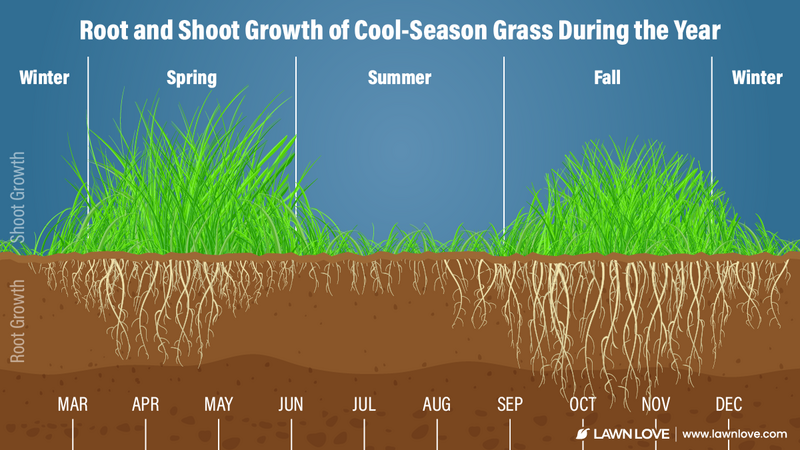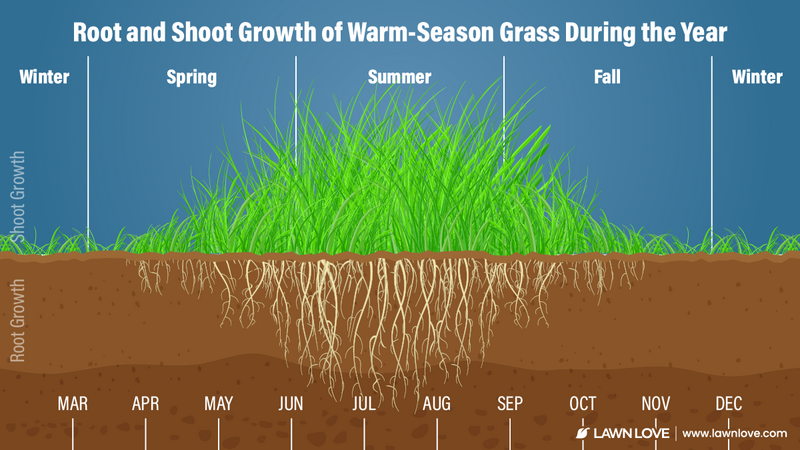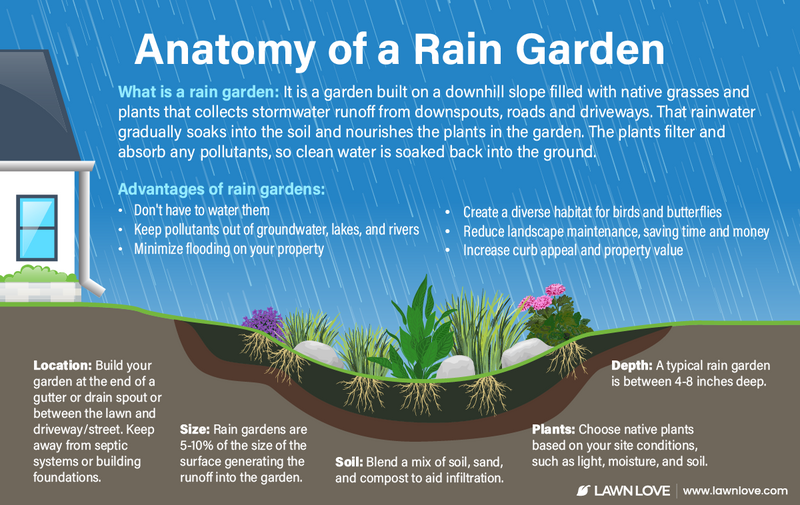What is the Easy Way to.help.water Drain From.my Yard

Puddles might be a kid's best friend, but they're a homeowner's worst enemy. Standing water in your yard threatens the health of your house, lawn, and family. Our guide will show you ways to get rid of standing water for good.
How to get rid of standing water
1. Water wisely
This solution is for you if you notice puddles in your lawn or driveway even when it hasn't rained recently.
The most common cause of standing water is improper watering practices. That includes a subpar watering schedule, not maintaining your sprinklers, or choosing the wrong sprinkler system for your yard.
Getting the right watering schedule
You might think more water is always better, but that's not the case for your grass. Turfgrass likes deep but infrequent waterings. Exactly how often and how much you should water your lawn depends on your grass type, your soil type, the average rainfall in your area, and the season.
Signs you're overwatering your lawn:
- Spongy feeling when you walk on your grass that lasts hours after you've watered
- Fungal disease (look for webbing, dead patches, or oddly colored spots)
- Lots of weeds or mushrooms
- Yellowing grass
An inch of water per week is a good rule of thumb for grass, but you need to consider your environment, too. If it rains, for example, skip the watering session that week.
Grass needs more water when it's actively growing and less when it's dormant. Cool-season grasses — Kentucky bluegrass, bentgrass, tall and fine fescue, and ryegrasses — are active in the spring and fall. Warm-season grasses — Bermudagrass, buffalograss, centipedegrass, St. Augustinegrass, and Zoysiagrass — are active in the summer.


You may know the proper amount of water to give your lawn, but do you know how long to run your sprinkler? The tuna can test is an easy way to measure the water output of your system.
How to perform the tuna can test:
- Place six empty tuna cans (or cans of the same size) in different areas of your lawn within range of your sprinkler's spray.
- Run your system for 15 minutes.
- Using a ruler, measure the depth of the water in the cans. Calculate the average of the measurements by adding them together and dividing by six.
- Use the table below to figure out how many minutes you should set your system to run per week.
| Average water depth after 15 minutes | Total minutes needed to water 1 inch/week |
| ⅛ inch | 120 |
| ¼ inch | 60 |
| ½ inch | 30 |
| ¾ inch | 20 |
| 1 inch | 15 |
Pro Tip: Instead of jumping to an automated watering schedule, observe your lawn for a few weeks and water only when you see signs of thirst (leaves that are wilted, curled, or brown). Take note of how often you're watering on average, and determine an automated schedule from there.
Sprinkler system maintenance
A faulty sprinkler system can cause pooling water. Do a thorough inspection of your irrigation system twice a year to make sure you're not running up your water bill or missing parts of your lawn.
Maintaining your sprinkler system includes:
- Cleaning sprinkler heads and filters
- Looking for damaged heads
- Making sure your heads are positioned to create the most effective spray pattern
Choosing the right sprinkler system
There's a reason there are so many different types of sprinkler systems out there. Choosing one that's suited to your particular lawn will reduce water waste and help you avoid overwatering.
For small lawns with hard-to-reach areas, a spray sprinkler head like an oscillating or stationary sprinkler is best. A rotor head system has enough force to reach the corners of large yards. If you have a small area to water, such as a vegetable garden or an individual tree, a drip system or bubbler will get the job done.
2. Dethatch and aerate
This solution is for you if you see signs that water isn't soaking into your soil. Signs include wilting turfgrass and puddles after minimal watering.
Thatch and compaction can prevent the ground from absorbing water.
You know how sometimes your skin needs a good scrub to get rid of all the dead skin? Your lawn needs something like that too: dethatching, the process of removing thatch.
Thatch is a buildup of grass stems, roots, and leaves that becomes a tightly woven layer between growing blades and the soil. A healthy amount of thatch is normal and makes your grass more resilient. When too much thatch builds up, it keeps water from seeping into the ground.
How to tell if it's time to dethatch:
- Cut out a small triangle of turf 6 inches deep.
- Squeeze the spongy layer above the soil and measure it.
- If it's more than one-half inch thick when you squeeze it, it's time to dethatch.
How to dethatch:
- Wait to dethatch until right after you mow the grass.
- Mow the grass at half its normal height.
- Use a dethatcher or a rake to pull up the thatch.
Once you've removed thatch, you can aerate your lawn. Soil can become compacted from consistent foot traffic, which slows drainage and deprives your grass of nutrients. Lawn aeration loosens up the soil and creates space for water and nutrients to move through.
How to know if it's time to aerate:
- Cut out a square foot section of your lawn at least 6 inches deep.
- Measure how deep your grass's roots are.
- If they're less than 2 inches deep, your soil may be compacted.
How to aerate:
Use a lawn aerator to make holes 4 inches deep and 2 inches apart from each other. If you don't have access to an aerator, a landscaping company can do it for you.
3. Add compost
This solution is for you if you notice puddles in your yard even when you're using the right amount of water.
The kind of soil you have in your yard determines your lawn's level of drainage. The three soil types you're most likely to find in your lawn are loam, sand, and clay.
Whereas water passes through sand and loam quickly, it has a tougher time moving through clay. Clay soil traps water, slowing down the drainage process, resulting in water sitting on top of the ground.
To improve drainage, amend the soil with organic matter, such as compost. This breaks up the clay and allows water to move through the soil at a faster rate. Make sure to dethatch your lawn first, or else the organic matter will have a tougher time reaching the soil.
4. Build a rain garden
This solution is for you if you have a slope in your yard that causes rainwater to collect.
A rain garden is simply a garden placed at the bottom of a slope or valley that catches stormwater and absorbs it to prevent flooding. Rain gardens are an excellent way to utilize a natural resource and improve the health of your lawn at the same time.

Benefits of a rain garden:
- Conserve water by using rain
- Attract pollinators like bees, butterflies, and birds
- Protect streams and rivers from pollution by filtering water
- Inexpensive way to improve your yard's drainage
- You may be entitled to a government rebate for building a rain garden
When choosing plants for your rain garden, look for native flowers, shrubs, and ornamental grasses that are found in wet areas like swamps and lowlands. Sedges, rushes, and grasses are especially useful because of their deep, complex root systems. If you decide to DIY your rain garden, skip the seeds and go for plants that already have an established root system.
5. Add a drainage system
This solution is for you if you have an improperly graded lawn or low slope.
Sometimes the shape of your landscape calls for a more intensive solution to yard drainage. A drainage system either channels water to an appropriate gutter (in the case of a French drain) or deep into the ground (in the case of a dry well).
French drainage systems
A French drain is a gravel-filled trench running from the low area in your yard to an exit point. A lining of landscaping fabric keeps soil and silt out. The bottom of the trench is sloped down slightly to encourage water to flow into the intended area, which could be a dry well, rain garden, or storm drain.
Usually, a perforated pipe is laid on top of the gravel and connected to an inlet grate installed at the point where water pools the most. The whole system is covered with topsoil.
Dry wells
A dry well is pretty much what it sounds like: a deep hole filled with rocks. Water moves into the well and drains through the rocks into the soil. Dry wells work well as termination points for French drains or beneath downspouts, especially if you get high rainfall. Install dry wells at least 10 feet away from your home's foundation and 3 feet away from property lines.
6. Take care of gutters and downspouts
This solution is for you if you see water along the sides of your house or stagnant water inside your gutters.
Cleaning gutters and downspouts
Your gutters can't do their job when they're clogged with leaves and debris. When water can't flow freely through them, you risk serious damage to your roof, foundation, and siding. That should convince you to haul out your ladder or hire a professional to clean your gutters for you.
Gutters should be cleaned twice a year. The best times are in fall after the leaves have fallen and in spring to get out any bird nests or pine needles.
How to clean your gutters
- Get your garden trowel, spade, or spatula ready for scooping.
- Position your ladder on dry, flat ground.
- Scoop out debris into a bucket or onto a plastic tarp below, working in small sections.
- Inspect for leaks as you go. You can fix these later with waterproof sealant spray or tape.
For downspouts, place a hose into the top opening and let it run for a few minutes. Use a plumbing snake to clear stubborn leaves.
Extending your downspouts
Downspouts should end at least 4 feet away from your home. When they're too close, they threaten your home's foundation and allow excess water to pool against the building instead of draining into the soil.
Options for extending your downspouts:
- Aluminum extensions are inexpensive and easy to install. They snap onto the existing downspout.
- Splash blocks are plastic or metal channels that sit on the ground beneath the downspout.
- Roll-out drain sleeves uncoil during heavy rain and allow water to pass through small holes. When the rain ends, they roll back up.
Why you should get rid of standing water
Water may be the source of life, but it also can be the source of disease, struggling lawns, and an unstable foundation.
How standing water impacts your house
Puddles can affect your home in a big way. When standing water builds up along the sides of your house, it puts pressure on the foundation. When the water evaporates during dry seasons, the pressure disappears too. This causes your home to shift back and forth, putting stress on the underlying structure. Over time, this can lead to an unstable foundation.
How standing water impacts your lawn
A soggy lawn is a recipe for bald spots and disease. Consistently wet grass can cause fungal diseases such as dollar spot, fairy ring, and red thread.
These diseases are difficult to combat, and fertilizer makes them worse. If you have to stop using fertilizer because of a disease, you'll end up with a nutrient-deprived, struggling lawn. Fight fungal diseases at their source by improving your yard's drainage before you have an issue.
How standing water impacts you
Standing water isn't just a threat to your property. It's also a breeding ground for bacteria that can harm you, your family, and your pets. Not to mention, it's a primary habitat for mosquitos. The pesky bugs will annoy you all summer long, and they can carry deadly pathogens like Zika and West Nile virus.
Main causes of standing water
Even if your area gets a lot of rain, your yard should be able to drain it by the next day. So, why isn't this happening in your yard? What's causing puddles?
The main causes of standing water are:
- Low spots in your landscape
- Improper watering techniques
- Drainage problems with your soil
The methods we described above will help you combat all three.
Well-rounded lawn care
These solutions for getting rid of standing water are just the first steps to having a successful lawn. All aspects of lawn care feed into each other. For example, proper mowing leads to fewer weeds which means denser grass. A dense lawn prevents soil erosion which means more nutrients available in the soil for a healthy lawn.
Staying on top of lawn maintenance also means it's easier to spot problems when they arise and identify their source.
A great first step is familiarizing yourself with your grass type:
- How much water does your grass type need per season?
- What soil pH do you currently have, and is it within the preferred range?
- How high should your grass type be mowed?
- What kind of fertilizer do your grass and soil prefer? When should you apply it?
Answering these questions will position you to have a (puddle-free) lawn you can be proud of.
Does lawn maintenance sound overwhelming? Call an expert. A professional landscaping company can help you maintain your landscape, address drainage issues, and perform seasonal cleanup.
Main Photo Credit: Michael Coghlan | Flickr | CC BY-SA 2.0
Rachel Abrams
Born and raised in Gainesville, Florida, Rachel Abrams studied creative writing at the University of Virginia. She enjoys volunteering at her neighborhood community garden and growing herbs in her New York City apartment.
richardsonpate1998.blogspot.com
Source: https://lawnlove.com/blog/ways-to-get-rid-of-standing-water/
0 Response to "What is the Easy Way to.help.water Drain From.my Yard"
Post a Comment